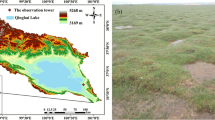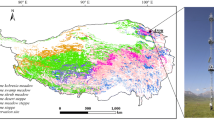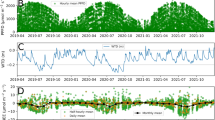Abstract
The terrestrial methane budget varies between different vegetation types and soil conditions and is highly uncertain for alpine grasslands. This work used eddy covariance techniques to continuously measure CH4 flux (NEEm) over a semiarid alpine meadow on the northeastern Qinghai-Tibetan Plateau from January 2017 to August 2019. The diel NEEm averaged 0.14 ± 0.98 nmol CH4 m−2 s−1 (mean ± S.D.), with a rough pattern of daytime release and nocturnal uptake. The 8-day NEEm exhibited a similar sinusoid variation, with a peak of 6.8 mg CH4 m−2 d−1 at the end of April and a minimum of −1.5 mg CH4 m−2 d−1 at the end of August. The maximum release probably coincided with the thawing of frozen soil in the root zone, and the peak uptake may be related to high soil temperature. Monthly CH4 uptake was highest from June to September and consumed 51.7 mg CH4 m−2 from the atmosphere. CH4 production in the other months totaled 647.6 mg CH4 m−2. The semiarid alpine meadow thus acted as a weak net CH4 source, releasing ca 0.6 g CH4 m−2 year−1 to the atmosphere. The boosted regression trees analysis shows that the sensible heat flux (H) is positively related to half-hour NEEm and accounted for 34% of its variability. The piecewise structural equation models reveal that the magnitude of the effects from soil temperature and vapor pressure deficit on 8-day and monthly NEEm were almost equal, but acted in opposite directions. Vegetation growth and soil moisture exerted little direct influence on NEEm variability at half-hour, 8-day, or monthly scales. Our results show that CH4 emissions of the nongrowing season dominate the annual methane budget for this alpine meadow area. Methane consumption during the growing season was significantly constrained by low soil temperature and high soil water content. These findings imply that semiarid alpine meadows may consume more methane during the growing season if soil temperatures increase and soil moisture levels decrease as projected by future warming scenarios, thus constituting a climate change negative feedback.
Graphic abstract







Similar content being viewed by others
References
Cao G, Xu X, Long R, Wang Q, Wang C, Yangong Du, Zhao X. 2008. Methane emissions by alpine plant communities in the Qinghai-Tibet Plateau. Biol Letters 4:681–684.
Chen W, Wang B, Zhang F, Li Z, Wang J, Yu G, Wen X, Niu S. 2020. Hysteretic relationship between plant productivity and methane uptake in an alpine meadow. Agr Forest Meteorol 288–289:107982.
Chen W, Zhang F, Wang B, Wang J, Tian D, Han G, Wen X, Yu G, Niu S. 2019. Diel and seasonal dynamics of ecosystem-scale methane flux and their determinants in an alpine meadow. J Geophys Res: Biogeosci 124:1731–1745.
Davidson SJ, Sloan VL, Phoenix GK, Wagner R, Fisher JP, Oechel WC, Zona D. 2016. Vegetation Type Dominates the Spatial Variability in CH4 Emissions Across Multiple Arctic Tundra Landscapes. Ecosystems 19:1116–1132.
Dean JF, Middelburg JJ, Röckmann T, Aerts R, Blauw LG, Egger M, Jetten MSM, de Jong AEE, Meisel OH, Rasigraf O, Slomp CP, In’T Zandt MH, Dolman AJ. 2018. Methane Feedbacks to the Global Climate System in a Warmer World. Rev Geophys 56:207–250.
Elith J, Leathwick JR, Hastie T. 2008. A working guide to boosted regression trees. J Anim Ecol 77:802–813.
Foken T, Göockede M, Mauder M, Mahrt L, Amiro B, Munger W. 2005. Post-field data quality control. In: Lee X, Massman W, Law B, Eds. Handbook of micrometeorology: A guide for surface flux measurement and analysis, . Netherlands, Dordrecht: Springer. pp 81–108.
IPCC. 2013. Climate Change 2013 - The Physical Science Basis: Working Group I Contribution to the Fifth Assessment Report of the Intergovernmental Panel on Climate Change. In: Stocker TF, Qin DH, Plattner GK, Tignor M, Allen SK, Boschung J, Nauels A, Xia Y, Bex V, Midgley PM, Eds. Cambridge University Press, . USA: Cambridge, United Kingdom and New York. pp 3–29.
Kato T, Hirota M, Tang Y, Wada E. 2011. Spatial variability of CH4 and N2O fluxes in alpine ecosystems on the Qinghai-Tibetan Plateau. Atmos Environ 45:5632–5639.
Le Mer J, Roger P. 2001. Production, oxidation, emission and consumption of methane by soils: A review. Eur J Soil Biol 37:25–50.
Lefcheck JS. 2016. piecewiseSEM: Piecewise structural equation modelling in r for ecology, evolution, and systematics. Methods Ecol Evol 7:573–579.
Li F, Yang G, Peng Y, Wang G, Qin S, Song Y, Fang K, Wang J, Yu J, Liu L, Zhang D, Chen K, Zhou G, Yang Y. 2020. Warming effects on methane fluxes differ between two alpine grasslands with contrasting soil water status. Agr for Meteorol 1:107988.
Li H, Zhang F, Li Y, Wang J, Zhang L, Zhao L, Cao G, Zhao X, Du M. 2016. Seasonal and inter-annual variations in CO2 fluxes over 10 years in an alpine shrubland on the Qinghai-Tibetan Plateau, China. Agr Forest Meteorol 228–229:95–103.
Li H, Zhang F, Li Y, Zhao X, Cao G. 2015. Thirty-year variations of above-ground net primary production and precipitation-use efficiency of an alpine meadow in the north-eastern Qinghai-Tibetan Plateau. Grass Forage Sci 71:208–218.
Li H, Zhang F, Wang W, Li Y, Lin L, Wang J, Guo X, Cao G, Yang Y, Li Y. 2018. The strongest EI Niño event stimulated ecosystem respiration, not evapotranspiration, over a humid alpine meadow on the Qinghai-Tibetan Plateau. Ecol Indic 91:562–569.
Li H, Zhu J, Zhang F, He H, Yang Y, Li Y, Cao G, Zhou H. 2019. Growth stage-dependant variability in water vapor and CO2 exchanges over a humid alpine shrubland on the northeastern Qinghai-Tibetan Plateau. Agr Forest Meteorol 268:55–62.
Lin X, Wang S, Hu Y, Luo C, Zhang Z, Niu H, Xie Z. 2015. Experimental Warming Increases Seasonal Methane Uptake in an Alpine Meadow on the Tibetan Plateau. Ecosystems 18:274–286.
McEwing KR, Fisher JP, Zona D. 2015. Environmental and vegetation controls on the spatial variability of CH4 emission from wet-sedge and tussock tundra ecosystems in the Arctic. Plant Soil 388:37–52.
Oh Y, Zhuang Q, Liu L, Welp LR, Lau MCY, Onstott TC, Medvigy D, Bruhwiler L, Dlugokencky EJ, Hugelius G, Imperio D, L., Elberling, B., . 2020. Reduced net methane emissions due to microbial methane oxidation in a warmer Arctic. Nat Clim Change 10:317–321.
R Development Core Team. 2006. R: A language and environment for statistical computing. Vienna: R foundation for statistical computing.
Reese H, Roger S, Sadanandan NEK, Ashton DH. 1996. Elongation of Eucalyptus roots during day and night. Tree Physiol 16:877–881.
Song W, Wang H, Wang G, Chen L, Jin Z, Zhuang Q, He J. 2015. Methane emissions from an alpine wetland on the Tibetan Plateau: Neglected but vital contribution of the nongrowing season. J Geophys Res: Biogeosci 120:1475–1490.
Sturtevant CS, Oechel WC. 2013. Spatial variation in landscape-level CO2 and CH4 fluxes from arctic coastal tundra: influence from vegetation, wetness, and the thaw lake cycle. Glob Change Biol 19:2853–2866.
Treat CC, Bloom AA, Marushchak ME. 2018. Nongrowing season methane emissions–a significant component of annual emissions across northern ecosystems. Glob Change Biol 24:3331–3343.
Treat CC, Natali SM, Ernakovich J, Iversen CM, Lupascu M, McGuire AD, Norby RJ, Roy Chowdhury T, Richter A, Šantrůčková H, Schädel C, Schuur EAG, Sloan VL, Turetsky MR, Waldrop MP. 2015. A pan-Arctic synthesis of CH4 and CO2 production from anoxic soil incubations. Glob Change Biol 21:2787–2803.
van den Pol-van Dasselaar A, van Beusichem ML, Oenema O. 1998. Effects of soil moisture content and temperature on methane uptake by grasslands on sandy soils. Plant Soil 204:213–222.
Wang J, Wang G, Hu H, Wu Q. 2010. The influence of degradation of the swamp and alpine meadows on CH4 and CO2 fluxes on the Qinghai-Tibetan Plateau. Environ Earth Sci 60:537–548.
Wang S, Yang X, Lin X, Hu Y, Luo C, Xu G, Zhang Z, Su A, Chang X, Chao Z, Duan J. 2009. Methane emission by plant communities in an alpine meadow on the Qinghai-Tibetan Plateau: a new experimental study of alpine meadows and oat pasture. Biol Letters 5:535–538.
Wang Y, Chen H, Zhu Q, Peng C, Wu N, Yang G, Zhu D, Tian J, Tian L, Kang X, He Y, Gao Y, Zhao X. 2014. Soil methane uptake by grasslands and forests in China. Soil Biol Biochem 74:70–81.
Wei D, Xu-Ri Tenzin-Tarchen, Wang Y, Wang Y. 2015. Considerable methane uptake by alpine grasslands despite the cold climate: in situ measurements on the central Tibetan Plateau, 2008–2013. Glob Change Biol 21:777–788.
Zhang F, Li H, Li Y, Guo X, Dai L, Lin L, Cao G, Li Y, Zhou H. 2019. Strong seasonal connectivity between shallow groundwater and soil frost in a humid alpine meadow, northeastern Qinghai-Tibetan Plateau. J Hydrol 574:926–935.
Zona D, Gioli B, Commane R, Lindaas J, Wofsy SC, Miller CE, Dinardo SJ, Dengel S, Sweeney C, Karion A, Chang RYW, Henderson JM, Murphy PC, Goodrich JP, Moreaux V, Liljedahl A, Watts JD, Kimball JS, Lipson DA, Oechel WC. 2016. Cold season emissions dominate the Arctic tundra methane budget. Proc Natl Acad Sci 113:40–45.
Acknowledgements
We sincerely thank the anonymous reviewers for the helpful comments. This work was funded by the Chinese Academy of Sciences-People’s Government of Qinghai Province Joint Grant on Sanjiangyuan National Park Research (YHZX-2020-07), the National Key R&D Program (2017YFA0604802), the National Natural Science Foundation of China (41730752, 41877547), and the Qinghai Innovation Platform Construction Project (2017-ZJ-Y20).
Author information
Authors and Affiliations
Corresponding authors
Ethics declarations
Conflict of interest
The authors declare no conflict of interest.
Additional information
Author Contributions HL, JZ, and FZ carried out all analysis. FZ and JW conceived the manuscript. All authors collaborated in interpreting the results and writing the paper.
Supplementary Information
Below is the link to the electronic supplementary material.
Rights and permissions
About this article
Cite this article
Li, H., Zhu, J., Zhang, F. et al. The Predominance of Nongrowing Season Emissions to the Annual Methane Budget of a Semiarid Alpine Meadow on the Northeastern Qinghai-Tibetan Plateau. Ecosystems 25, 526–536 (2022). https://doi.org/10.1007/s10021-021-00669-x
Received:
Accepted:
Published:
Issue Date:
DOI: https://doi.org/10.1007/s10021-021-00669-x




